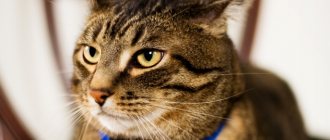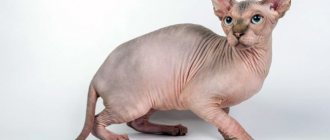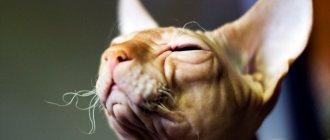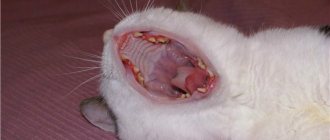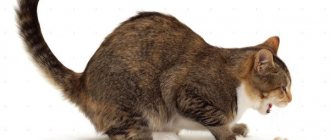The appearance of black dots that look like dirt on a cat's chin indicates the development of acne. Sometimes pathogenic bacterial microflora is involved in the process and inflammation occurs, pustules with pus are formed. To prevent the development of such pathologies, owners should be aware of measures to prevent the appearance of black spots on a cat’s chin, as well as methods of treating them.
Definition of disease
Acne is a multifactorial pathology in which comedones (blackheads) form on the skin of a cat’s chin. These formations occur with increased secretion of the sebaceous glands in conjunction with a disruption of the keratinization process in the stratum corneum of the epidermis.
Acne affects cats of any gender, age and breed, regardless of the conditions of detention.
There is no single cause for the appearance of blackheads in cats. Predisposing factors for their formation include non-compliance with basic rules of care and nutrition, stress, infectious and parasitic diseases.
Note! According to statistics, neutered pets practically do not get acne.
Causes of skin rashes in pets
This pathology in animals is very similar to human acne and is called acne. This disease is an inflammation of the sebaceous glands in a cat, which is caused by excessive clogging of pores due to disruption of the process of death of the upper layer of the skin and the functioning of the sebaceous glands.
The appearance of acne on the chin and in the corners of the lips is the first visible sign of this disease. The main internal and external reasons that contribute to the development of acne can be identified:
- Failure to fully observe the pet's personal hygiene. Most often it is characteristic of cats or cats that were taken from their mother at an early age, as a result of which they could not learn to wash themselves in hard-to-reach places. This often entails the development of inflammatory processes in the skin, especially in areas with the shortest hair possible.
- Sudden changes in temperature. Long-haired cat breeds have a hard time withstanding the heat - their pores become greatly enlarged, which leads to the accumulation of dirt and the appearance of acne.
- Heredity, hormonal imbalances and stressful situations associated with a change of place of residence, nutrition, deterioration of liver function and general well-being can lead to severe blockage of the sebaceous glands.
- Infection. While playing or washing, the cat may accidentally scratch itself. Often, the spread of bacteria is facilitated by poor-quality or disposable food and water containers and infrequent bathing of the pet.
- Lack of important vitamins and minerals. An unbalanced diet and weak immunity also lead to the appearance of black spots on the chin of cats that look like dirt.
You might be interested in: Why are Britons constantly in tears?
The disease must be treated at an early stage of development, otherwise there is a high chance of progression and the appearance of ulcers at the site of acne. Please note that spayed and neutered individuals are considered least susceptible to anke infection.
Causes and mechanism of disease development
The reason for the failure of the keratinization process of epidermal cells in cats has not been established. Therefore, experts identify several factors that contribute to this phenomenon and lead to the appearance of black spots on the fur of cats. These include:
- increased secretion from the sebaceous glands of the epidermis;
- sticking of food debris to the beard or skin on the cat’s chin;
- decreased immunity after severe infectious diseases, as well as during the rehabilitation period after injuries or operations;
- dysfunction of the endocrine glands;
- intoxication phenomena caused by diseases of the gastrointestinal tract, liver and pancreas;
- allergic reactions;
- skin pathologies;
- dermatophytoses;
- demodicosis;
- improper care of the animal's skin and fur;
- some infectious and parasitic diseases;
- severe or prolonged stress.
Important! Owners must carefully monitor the cleanliness and integrity of the dishes from which the animal eats and drinks. Pathogenic microorganisms accumulate in chips, scratches and cracks, then enter the pet’s skin and can easily provoke inflammation and cause sores on the chin of cats.
The mechanism of comedones formation in cats occurs in 5 stages:
- Increased secretion from the sebaceous glands (sebum).
- Blockage of the ducts of the sebaceous glands with a mixture of sebum and dead epithelial cells.
- Formation of open cysts (comedones) at the mouth of the hair follicle.
- Oxidation of the contents of comedones in the presence of oxygen. Visually, this is marked by the appearance of black dots on the cat’s skin.
- Opening of comedones.
If comedones open into the external environment during injury by an animal, infection occurs and purulent inflammation develops. But sometimes cysts greatly increase in size, become inflamed and open into the dermal cavity. In this case, surrounding tissues are involved in the process. The cat's immune system tries to prevent the spread of pathogenic microflora and releases a huge number of white blood cells. When they die, they form purulent exudate, which accumulates in the internal cavity and then tends to come out. Clinically, this is manifested by the formation of abscesses, severe itching and even pain. Scratching the abscess leads to secondary infection, the formation of non-healing ulcers, which, when dry, form scabs on the cat’s chin.
Important! Attempts by cat owners to open comedones or abscesses on their own without following antiseptic rules often lead to re-infection and the development of complications.
Flea nutrition
Fleas differ according to the type of host in whose fur they parasitize, what kind of parasites there are - cat, dog, rabbit, bird, etc. - depends on the type of animal. Each type of flea has adapted over the years to the structure and temperature of the skin, blood components and other characteristics of the mammal. If there is a lack of food, they can try to bite and consume the blood of another owner; from this point of view, cat fleas are the most picky: they are able to feed on both a dog and a person.
Moreover, adult insects do not live permanently in the host’s fur, but jump to it only during meals. Their main habitats are things and surfaces not far from the cat. They prefer to eat food daily, but can go hungry for a long time, up to several months.
The only exception is the ectoparasites of nomadic animals (camels, sheep, etc.), they constantly live on their bodies in the wool.
Interesting!
Fleas are the only representatives of insects that have not changed over the past 50 million years, i.e. ancient specimens are identical to modern ones.
Clinical symptoms
Sores in cats are localized mainly on the lower jaw. Sometimes, in addition to the beard, black specks can be found along the line of the upper and lower lips.
At the first stage of the disease, clinical symptoms are noticeable only in hairless cats in the form of small dirty dots. In 50-55% of cases, no further development of pathology occurs, and the animals do not show concern.
In 45% of cases, feline black comedones on the cat's chin progress to sores such as papules and pustules. Their symptoms are:
- the appearance of red spots on the skin of the chin;
- formation of painful tubercles;
- the appearance of a spherical or cone-shaped abscess, upon pressing on which a certain amount of purulent exudate is released.
If squeezing out the abscess and its subsequent treatment was carried out in compliance with antiseptic rules, then after 2-3 days a dry crust appears in place of the pustule. After its removal, no scars remain.
However, quite often the cat scratches the abscess on its own, which provokes the development of a secondary infection and the formation of a boil. Clinically this manifests itself:
- hyperemia and swelling of the chin tissue;
- an increase in local temperature;
- itching and soreness, which provoke further scratching;
- thickening of the skin in the lower jaw area.
After the completion of the process of maturation of the boil and the formation of a connective tissue capsule around it, pain and itching go away, the temperature returns to normal, and the purulent exudate is visible through a thin layer of skin.
Appearance
The cat flea (Ctenocephalides felis) belongs to the order of wingless insects that feed on the blood of mammals. Usually fleas parasitize on a certain type of animal: feline fleas on cats, canine fleas on dogs, rat fleas on rodents, as well as rabbits and birds, but if necessary, they can easily change the type of host. Moreover, in appearance they are almost identical, so only an entomologist can determine the exact variety.
Fleas on a cat
What does a flea look like on a cat:
- the flea's body has a laterally flattened shape, which helps it quickly move between the hairs;
- the dense shell is covered with bristles, with which it clings to wool or feathers;
- the chitinous cover is very durable and difficult to crush with your fingers; the insect can only be destroyed by crushing it between the nails or on a hard surface (see photo of a flea on a cat);
- The flea size is 1-5 mm, on average - about 2-3 mm, and females are larger due to the round abdomen in which they carry eggs; after saturation with blood, the parasite increases almost 2 times.
The color of fleas living in a cat's fur often depends on whether they are hungry or have already drunk blood: it can vary from light red to dark brown, almost black. They absorb blood through their proboscis, which they use to pierce the skin and suck out food.
The main difference between fleas is their incredible jumping ability and speed of movement among fur; it is almost impossible to catch it with your fingers.
On a note!
Long strong legs give the insect the ability to move quickly and jump at any angle in length and height at a distance of up to 30 cm, for which fleas are considered one of the best jumpers in the world. At the end there are 2 claws for attaching to wool.
At the back of the insect there is a tactile organ consisting of sensitive hairs. Fleas do not have wings; in the process of evolution, they adapted to a parasitic lifestyle and lost their flight apparatus.
Diagnosis
In order to correctly prescribe treatment, a veterinarian must make an accurate diagnosis and find out the causes of the black spots on the cat’s chin. This can be done based on clinical and laboratory studies.
First of all, the doctor pays attention to the presence of black spots or spots on the cat’s chin. Next, he makes a scraping from the skin and sends it to the laboratory to exclude dermatomycosis and parasitic diseases (demodex).
If a cat has purulent sores on the chin near blackheads, then a veterinarian will conduct a cytological analysis of the epidermis for the presence of pathogenic microflora.
Infection and diagnosis
It is much easier to catch a parasite than to get rid of it. A cat can pick up fleas just by walking outside. Fleas are also capable of jumping from one animal to another. Flea eggs can also be brought into a home by a person, on shoes or on clothing. It is also possible for the animal to be re-infected if, after flea baiting, their eggs remain on furniture, carpets or somewhere else.
The first symptoms of infection do not appear immediately; in the first days, the cat may not show that something is bothering her, perhaps she will begin to wash herself more thoroughly and also itch. But cats, by their nature, are often concerned with keeping their fur clean, so at first a person may not attach any importance to this. But the longer fleas infest your pet's fur, the more nervous his behavior will become. In addition to frequent scratching, the animal may begin to bite itself and become more aggressive towards people.
In order to detect fleas on a cat's body, you need to carefully examine its stomach. The fur in this place is thinner and sparse, unlike the rest of the body, so it will be easier to see fleas and their bites here. If you couldn’t see the fleas themselves, then you need to pay attention to small black particles on the stomach and in the fur; these are the remains of fleas’ vital activity, which also signal their presence.
Signs of fleas in a cat:
- The animal became irritable and nervous;
- Active and bites himself;
- Sleeps poorly and eats little;
- For no apparent reason he screams pitifully;
- The fur looks shabby.
You need to carefully examine the cat's belly; there is a high probability of parasites appearing.
Treatment of black spots on a cat's chin and prognosis
It is not advisable to treat acne at the comedonal stage (when single black dots are visible on the cat’s chin), since therapy is required only at the stage of pustules or boils. The veterinarian informs the owner about this and gives him clear instructions regarding further monitoring of the disease.
The opening of the boil is carried out only after the formation of the connective tissue capsule. When trying to squeeze out an immature abscess in a cat, pathogenic microorganisms can enter the systemic bloodstream and cause sepsis.
Important! To eliminate the pathology, complex treatment is necessary, which includes local and systemic therapy. If deep boils are present, surgery may be necessary.
Local therapy
First, the hair on the chin of a kitten or adult cat is trimmed. Further treatment is carried out according to the following scheme:
- daily cleansing of the skin with antiseborrheic shampoos, which contain salicylic alcohol or ethyl lactate (used until the clinical manifestations of the disease disappear);
- treatment of the affected area with a 1% chlorhexidine solution;
- lubricating acne with antibacterial ointments or lotions.
Important! After eliminating the clinical signs of acne, doctors recommend continuing to treat the skin with antiseborrheic shampoos 2 times a week for a month to prevent the development of relapses.
Systemic treatment of black spots on the chin of a cat
In the presence of secondary infection, antibiotic therapy is carried out. Medicines are selected taking into account the results of a cytological study. To eliminate severe itching, a specialist may prescribe steroid drugs, the dosage and course of use of which is determined individually for each animal. Also, foods containing essential fatty acids must be included in the cat’s diet.
Despite the favorable prognosis of treatment, most cats experience relapses over time. Therefore, if the owner notices that spots similar to dirt have appeared on the cat’s chin, he should contact a veterinary clinic as soon as possible. Such blackheads are a consequence of metabolic disorders caused by various factors. Untimely treatment leads to their proliferation, enlargement and infection with pathogenic pyogenic microflora. Self-treatment of acne in cats is contraindicated, as it requires the use of antibacterial and steroid drugs, which can only be prescribed by a veterinarian.
What is acne
Feline acne is a skin disease that causes the formation of comedones (blackheads) on the lips and chin.
Comedones are plugs of a mixture of sebum and exfoliated epithelial cells of the hair follicles. The black color of the formation is obtained due to the pigment melanin, which colors stagnant sebaceous secretions. That’s why comedones are called “blackheads” or “dirt.” The sizes of the rashes vary - from a millet grain to a pea.
The occurrence of acne does not depend on gender, breed, or age (it can even occur in a kitten). The disease manifests itself episodically, goes through cycles, or is a constant companion of the cat. Also, acne develops regardless of whether the animal is spayed/neutered or not.
Reasons for appearance
The reasons for this problem can be completely different. In particular, the following factors are encountered:
- A previous illness, moving to another place of residence, a stressful state.
- Immunity problems. It often happens that black spots appear in kittens or in adult cats that experience problems with immunity.
- Incorrect structure of hair follicles.
- Improper care of your pet can also be a cause.
- Animals with long hair often face this problem because it is more difficult for them to groom themselves.
- Violation of detachment of the upper layer of the epidermis, problems with metabolism.
Regardless of the breed, the animal may develop such problems. It also happens that acne appears and then simply goes away on its own. But if the animal previously had problems with skin regeneration, then blackheads may appear again and in a more complex form.
Key points of the treatment plan
It is not difficult to get rid of acne in cats at home. By following simple rules of hygiene, maintaining the most sterile conditions of the diseased area of skin on the chin, the likelihood of the spread and penetration of pathogenic microorganisms deep into the epidermis of the animal will thus be reduced to zero.
Treatment of a problem such as cat acne is based on the general treatment regimen for skin diseases presented below:
- Regular shampooing of the affected area.
- Before starting treatment procedures, a disinfectant wipe with 3% hydrogen peroxide is required.
- For long-haired pets, it is better to shave the hair in this area.
- The application of external preparations should be preceded by the dissolution of the stratum corneum of the skin.
- Treatment with antibiotics is usually necessary in complex cases when the area of the rash is rapidly increasing.
Self-medication is not the best solution
Among cosmetic products, as many owners note, lotions and scrubs help relieve itching. Compared to medications, which only a specialist should prescribe, the owner can purchase these on his own or select them from his own supplies. However, even with such seemingly safe remedies, you should be careful: adding allergic acne to the initial acne in cats can simply aggravate the course of the disease.
In any case, treatment of the disease should be under the full supervision of a veterinarian. Having a sufficient level of qualifications, a professional will objectively compare laboratory data with the information received during the examination.
The intensity of therapy for pet acne is determined by the frequency of rashes, the duration of the disease and its degree of neglect. For mild forms of manifestations, local treatment is usually prescribed, and for more extensive skin lesions, complex treatment is prescribed. At the same time, the main thing:
- Do not squeeze out blackheads and blackheads.
- Adjust your pet's diet, eliminating possible allergic irritants.
- Treat until complete recovery, since early relief does not guarantee final success.
Preventive measures
Methods for preventing the formation of acne on the surface of a cat’s skin include the following:
- only metal bowls for feeding
- constant cleanliness of dishes for feeding the animal;
- regular examination of the animal’s chin for the appearance of new rashes;
- exclusion of possible diseases;
- wiping the animal's chin immediately after feeding;
- If a cat has a predisposition to acne, the animal’s chin should be treated with disinfectant solutions after each meal.
